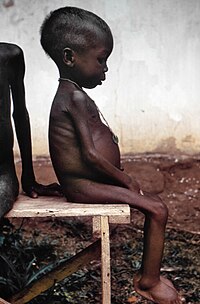
Photo from wikipedia
Background Three different diagnostic criteria are used to identify children aged 6 to 59 months with acute malnutrition: weight-for-height (WHZ), middle upper arm circumference (MUAC) and bilateral pitting oedema. Prevalence of… Click to show full abstract
Background Three different diagnostic criteria are used to identify children aged 6 to 59 months with acute malnutrition: weight-for-height (WHZ), middle upper arm circumference (MUAC) and bilateral pitting oedema. Prevalence of malnutrition from surveys is among the most-used decision support data, however not all diagnostic criteria are used to calculate need, creating a mismatch between programme planning and implementation. With this paper, we investigate if such discrepancies are observed in Mozambique. Methods Population-based nutritional anthropometric surveys from 45 districts in Mozambique conducted by the Technical Secretariat for Food Security and Nutrition (SETSAN) and UNICEF between 2017 and 2019 were analysed. We used Cohen’s kappa coefficient to measure inter-rater agreement between WHZ and MUAC, Spearman’s rank-order coefficient to assess the correlation, binary logistic regression to investigate factors influencing WHZ and MUAC diagnostic classification. We compared acute malnutrition caseload estimates by WHZ, MUAC and oedema to caseloads from combined prevalence estimates. Results WHZ and MUAC rarely agree on their diagnostic classification (κ = 0.353, ρ < 0.001) and results did not vary by province. We found positive correlation between WHZ and MUAC (rho = 0.593, ρ < 0.0001). Binary logistic regression explained 3.1% of variation in WHZ and 12.3% in the MUAC model. Girls (AOR = 1.6, ρ < 0.0001), children < 24 months (AOR = 5.3, ρ < 0.0001) and stunted children (AOR = 3.5, ρ < 0.0001) influenced the MUAC classification. In the WHZ model, children < 24 months (AOR = 2.4, ρ < 0.0001) and stunted children (AOR = 1.7, ρ < 0.0001) influenced the classification, sex had no effect. Caseload calculations of global acute malnutrition by WHZ and/oedema-only and by MUAC and/oedema-only yielded less children than caseload calculations using the combined prevalence estimates. Similarly, caseload calculations for SAM by WHZ and/oedema-only and SAM by MUAC and/oedema-only yielded less children than the respective combined prevalence calculations. Conclusions Given the discrepancy in diagnostic classification between WHZ and MUAC in Mozambique, using either one alone for calculating burden underestimates the real number of children in need of treatment and negatively affects nutrition programme planning. We recommend that use of the combined prevalence estimates, based on the three diagnostic criteria of WHZ, MUAC and oedema, be officially adopted. Further analysis is needed to detail the programmatic impact of this change.
Journal Title: Archives of Public Health
Year Published: 2020
Link to full text (if available)
Share on Social Media: Sign Up to like & get
recommendations!